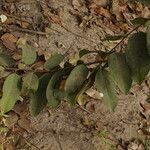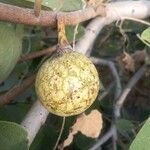Shrub or small tree (0.8-)1.5-10 m tall; bark grey-brown, often rough and corrugated; young stems mostly ferruginous velvety to greyish tomentose, at length glabrous; leaf-bases and scars mostly prominent, often with raised lines decurrent beneath them. Leaf-blades oblong to ovate or elliptic, (4-)6-18.5(-34) cm long, 2.5-11.5(-26) cm wide, obtuse or apiculate to rounded or slightly emarginate at the apex, cuneate or truncate to cordate at the base, papery to coriaceous, glabrous or sparsely pubescent above save for hairy midrib, glabrescent to thickly ferruginous velvety beneath; venation reticulate beneath; petiole (0.5-)1-2(-2.5) cm long, glabrous to velvety tomentose. Flowers solitary or in fascicles of 2-4, extra-axillary; pedicels 1-2.7 cm long, tomentose; bracteoles 1-2 or wanting, small. Sepals ovate-triangular, 3-4 mm long, 4-5 mm wide, obtuse to acute, pubescent or tomentose outside, glabrous inside. Petals greenish outside, creamy to yellowish or pinkish within, sometimes blotched with purple, or crimson blotched at base inside, fleshy; outer broadly ovate, 0.8-1.2(-1.5) cm long, 0.9-1.1 cm wide, obtuse, adpressed greyish or yellowish pubescent outside, glabrous or minutely papillose within; inner narrowly oblong, trigonous, 0.8-1 cm long, 2.5-3 mm wide. Stamens linear, 1.7-2.5 mm long; anther-cells equal or unequal at the base; connective-prolongation obliquely capitate, minutely papillose. Carpels cylindric, 1-1.5 mm long, glabrescent. Fruiting stalks 1.5-5 cm long; fruits yellow or orange, ovoid or globose, 2.5-5 cm long, 2.5-4 cm wide; areoles slightly raised, very obtuse, glabrescent. Seeds numerous, orange-brown, cylindric, oblong or obovate-oblong, compressed, 0.8-1.4 cm long, 4-6(-8.5) mm wide, 3.5-5 mm thick; aril fibrillated, ± 2 mm long.
A shrubby tree which looses its leaves during the year. It grows to 2-6 m high. The bark is grey and smooth. The young stems are hairy and orange. The older bark becomes thick and folded. It peels off to expose paler patches. The leaves are oval and blue-green. They are 18 cm long. They are curved like a spoon. Under the leaf is hairy. The leaves have a peculiar smell when crushed. The flowers are yellow green. They occur as one to three together hanging down below the twigs. The fruit is rounded and 2-7 cm across. It is smooth but divided like lots of small parts fused together. It is green when unripe and turns orange-yellow when ripe. It has a smell like a pineapple. It has many seeds. They are pale brown. The sweet pulp around the seeds is edible.
Leaves petiolate; lamina 6–18.5 (30) x 3–11.5 (21) cm., oblong to ovate or elliptic, obtuse or apiculate to rounded or slightly emarginate at the apex, cordate to truncate or cuneate at the base, chartaceous to coriaceous (more rarely membranous), yellowish-or glaucous-green and ± sparsely puberulous or more rarely glabrous above, paler or glaucous and densely sericeous-tomentose to glabrescent below, with green to reddish-purple nerves and densely reticulate venation prominent below; petiole (5) 10–20 (25) mm. long, densely tomentose to glabrous.
Petals greenish outside, yellow to cream within, fleshy, the outer ones 8–12 (15) mm. long, broadly ovate, concave, obtuse, shortly and densely greyish-or yellowish-appressed-pubescent outside, glabrous, or minutely papillose within, the inner ones somewhat shorter, narrowly oblong, almost triquetrous.
Branches cylindric or with opposite pairs of raised lines decurrent from the leaf-bases, ± densely brown-to yellow– or greyish-tomentose at first, eventually glabrous.
Stamens 1.75–2.5 mm. long, linear, with thecae equal or unequal at the base; connective-prolongation obliquely capitate and minutely papillose; filament ± cuneate.
Flowers solitary or rarely 2–4-fasciculate, extra-axillary, erect or ± deflexed; pedicels 10–20 mm. long, shortly tomentose; bracteoles 0–1 (2), small.
Fruit on a pedicel 15–30 mm. long, erector spreading; syncarp 2.5–5 x 2.5–3 cm., ovoid or globose, obtusely squamose, glabrescent, orange or yellow.
Sepals 3–4 mm. long, ovate-triangular, obtuse to acute, pubescent or tomentose outside, glabrous within.
Seeds numerous, c. 10 mm. long, cylindric or ± flattened, orange-brown; aril pectinate.
Carpels c. 1–1.5 mm. long, cylindric, glabrescent; stigmas subclavate.
Shrub or small tree, 1.5–8 (10) m. high.







